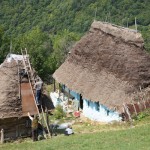‘What are you staring at us for ? Why are you taking pictures ? Get away from here ! Leave us in peace !’
We saw the homestead at a bend on the road which passes through the Râmeti village in the Western Carpathians. An incredible image : a house, a shed and a barn exactly as they used to be a hundred years ago and which now seem to exist only in ethnographic museums. Three elderly people, patching a thatch roof with a sheet of metal.
Beyond the shame at being rightfully scolded, I felt that their aggravation at our enthusiasm accurately expresses a fundamental contradiction found in the attitude we have towards rural heritage. We enjoy old houses, traditional architecture (and an entire culture) ; we rightfully despair at the accelerated destruction of this heritage ; and, in a cultural continuity of several hundred years old cliches, there is, tucked in some corner of our minds, the absurd wish to preserve an unspoiled way of life, which we may contemplate with great satisfaction.
But our only wish is to contemplate it, for we could never live in authentically traditional conditions. The homestead I was describing was not only beautiful, but also wretchedly poor. And the people who live in conditions which today are hardly acceptable and uncertain surely have a wholly different view from ours and, in any case, they have no desire no become living actors in folkloric dioramas.
Their desire for modernisation is a legitimate one, and the exaggerations of new buildings, as well as the rejection of old ones can be understood if we consider their need for compensation and the frustrations of a society who, on the one hand, is still building its identity based on a mythical rurality, and on the other, still uses the term ‘peasant’ in a derogatory way.
How can we reach a balance between the preservation of cultural assets and the inevitable development? How can we navigate between the economic potential, the resistance against the tidal wave of recent built horrors, the ever more potent ethno kitsch, as well as nostalgia for times gone by and the populistic and touristic reinvention of the past?
In order to clarify this problem a bit, we have begun a book and an exhibition, both of which are titled ‘Beyond the city’. They will become public on 25th September and will transport us from the villages in in the Western Carpathians to the new suburbs around big cities, from rehabilitations and restorations that refer not only to architecture, all the way to new houses located in natural environments or built sensibly, from master carpenters and ironsmiths to eco farm vegetables sold on Facebook. Let us see what living in the countryside means today.
Photo: Patrick Violet
* Published in Zeppelin no. 117 / september 2013


